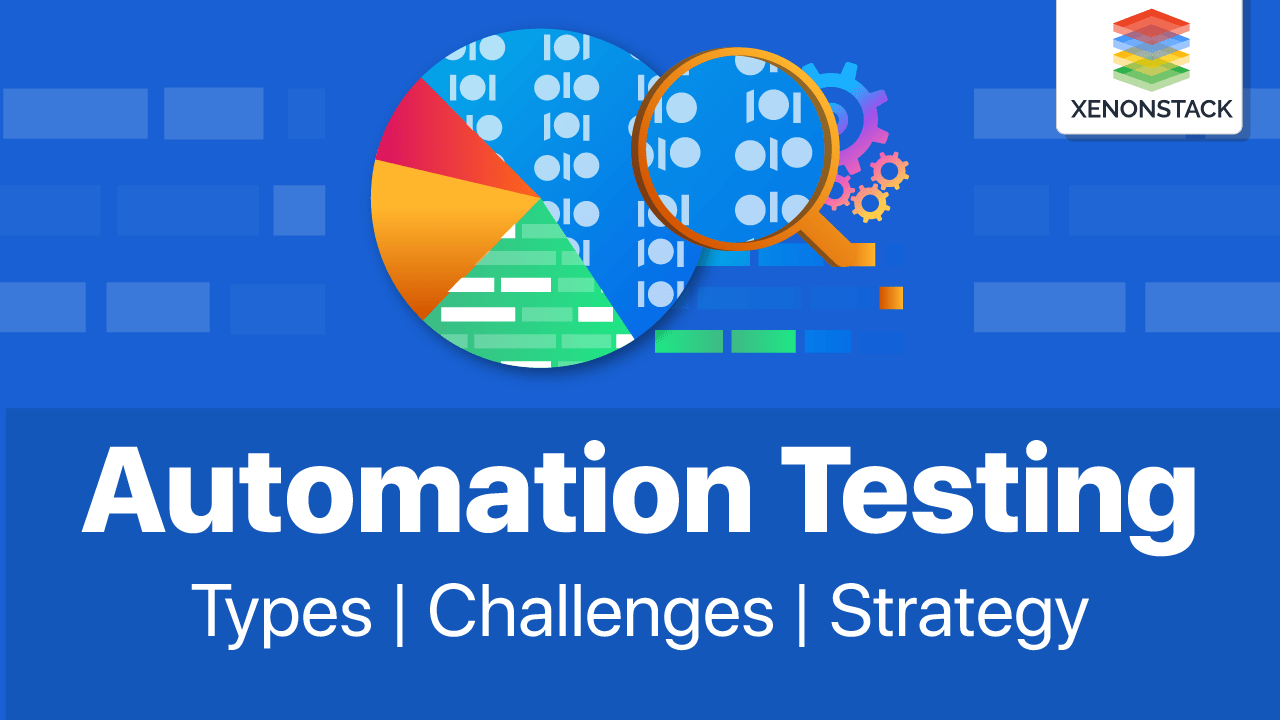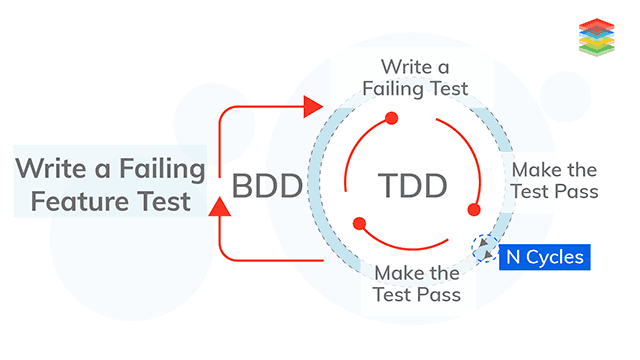
Introduction to Automation Testing
Software testing, including test automation services, encompasses several methods, tools, and practices crucial for validating a software application's functionality across different levels. In the domain of automation testing, practitioners undertake various forms of software testing, whether manual or ad hoc—such as refreshing a webpage post-code modification to confirm functionality. Test automation services play a pivotal role in the software development lifecycle, involving the meticulous scrutiny of applications under diverse real-life conditions. This process ensures that the developed software/application effectively serves its intended purpose. Through comprehensive testing, applications are scrutinized for bugs, thereby bolstering product stability.Contract Testing in the Microservice architecture for splitting the application into small services, which plays a separate role in system. Source: Contract Testing for Applications
What is Automation Testing and its Types?
Automation testing is a combination of two words that are: Auto and Matos. Auto means self, and Matos means moving. It means "move by itself." Automated systems also achieve significantly superior performance than the performance possible with manual systems, concerning power and speed. In a fundamental sense, automation means — the use of some technology to complete a task.What are the Types of Automation Testing?
There are three main Types of Automation Testing:Fixed Automation Testing
The equipment configuration sets this sequence of processing operations. So each operation is usually straightforward, generally using linear or rotational motion to achieve results.Programmable Automation Testing
In this, a sequence of operations can be changed to accommodate different product configurations. It should do by using a set of coded instructions, which is read and implemented by the system by using another programmer.Flexible Automation Testing
A system can be quickly and easily re-tasked to change the design for both low and high manufacturing.Misconceptions About Automation Testing
Automation is a replacement for testers.
Nowadays, most companies are moving towards Automation Testing in which testers can write the scripts and test the software. Scripts cannot write automatically by automation; the testers behind them investigate the complete criteria and think according to it to write the scripts, so a tester's perspective will always be valuable.Automation will provide you with more free time.
The misconception that automated testing gives you more free time which is true as well as false. In manual testing, most of the time used for exploratory and functional testing where testers would manually search for errors. Once that process completes, the manual tester will repeatedly go through the same steps again, like Regression Testing. In Automation testing, testers will spend most of the time writing the scripts and making improvements to these tests repeatedly as adjustments are needed. Once the analysis is complete, automated testing allows for the recycled use of tests so that they should not go through this whole process again.The Cost of Automated Testing is Too High
It is a big misconception. Nowadays, we have a number of options for automation like Katalon Studio, Selenium, Robot Framework, etc., which are entirely free tools. If we go for the paid tool, that will also be beneficial because, at first, the investment in automated testing might seem cost-prohibitive, especially if you are in a smaller company. But after analysis, over time, automated testing pays for itself. Automated testing reduces the cost and need for multiple code revisions, so the investment pays out with time. Repeating these tests with manual testing is costly and time-consuming, but automation can be run again and again at no additional cost.Automated Testing is Better Than Manual Testing
The reality is that there is no "better" or "worse" between manual and automated testing. There's just "different." Both have their advantages and disadvantages. Perform manual testing first before automation. For every new build, firstly, we have to do manual testing on it. Automated testing is mostly used after the build has developed. Lengthy tests that are avoided during manual testing can be run unattended. In the end, both have their perspectives, especially if the application you're developing is too complicated to rely on the manual approach.Automated Testing Inhibits Human Interaction
Another common misconception about automated testing is that it inhibits human interaction. Automated testing is clear and faster than testers could do without suffering human errors, so this misconception is understandable. That said, products are designed to facilitate a collaborative approach by including features. It allows co-workers to go through a piece of test coding and then comment on the test script. Automation testing doesn't replace the face-to-face communication that's a necessary part of software development. It enhances that aspect by providing another channel through which to communicate.
Read more about Quick Guide to Regression Testing Tools and Techniques
When and How to Automate Testing?
Test automation is utilizing software, and that might be a script, macro, or third-party solution. Such quick test professionals handle the execution of test cases and compare actual outcomes to expected results. The setting of test preconditions or test automation for other test control and reporting functions might be used. Still, again, test automation uses a program, a macro, or a third-party solution to perform specific testing functions, even if it's for test preparation.What are the Benefits of Automation Testing?
Speed of execution
So automated a test should significantly decrease the execution time. You can also lower the execution time by distributing automated tests and running them on multiple machines so with the speed of execution. Lets you have a manual process, and it takes you about an hour to perform that manual test. If you do an excellent job in automating the process, it should execute in two to ten minutes at the most.Reliability, Repeatability, and Re-usability (3Rs)
With the manual process lets, you have got john tester executing a test, and performing that test. He implements the actions, the navigations, and checks for particular results, but he has not standardized the manual test. He goes off on vacation, and mary, the tester, takes over. She may end up performing that test in an entirely different way by automating that testing process. You can standardize it if you will and then thus introduce the 3Rs.Coverage
It means coverage of requirements, so since you are decreasing the execution time, you can validate a significantly higher number of conditions and scenarios, thus improving your testing process.Execute Remotely
The other benefit is you can execute the automated test remotely and unattended, so you can schedule a series of automated tests to kick off at 9 p.m. and then actually come in the next day and perform your analysis. Now before your automation, there were no. Of questions to ask yourself. Look at your test case, and your test plans and ask yourself if your environment and application supported by the automation solutions are using dot net or java, etc., also as yourself is the application interfaces are somewhat stable if there have minor changes, then automated process handle those kinds of changes but if its going to be significant change such as navigation or the removal/ addition of certain objects which are necessary for the testing process now might not be the right time to automate. Another important question before you start the automation do you know the application, do you know the expected results, do you know how to navigate while you are automating the test? That is not the right time to be experimenting with the application. Some good candidates for automation:- Tests run for every build of an application
- Tests using multiple sets of data
- Tedious and prone to human errors
- One time testing
- Ad-hoc testing
- Emergency testing
- Usability testing
- Tests without predictable results

What are the Metrics for Automation Testing?
Annual Savings & Time and Money
QA matters in terms of bringing a real competitive advantage to your business. It is not just making sure that things work that's a huge part of it, but if we make sure that things work as their designed day in and day out, then we can have a competitive advantage. We convert a lot of people from either old-style scripted tests/ from complete manual testing. So one of the testings we look at is what type of hours and annual savings we can get from moving from a manual or scripted test to a work-soft automated test. It usually turns out that those numbers are quite high beyond that. We started looking at things that we can do, for example, in terms of sap impact analysis and saving people time to determine if they have gaps in their test library.Defect Reduction
We also look at defect reduction as it turns out that defect reduction is one of the most significant metrics that we impact on an annual basis. Because by using work softly, you are just going to catch more things earlier in the development or the rollout process so you will save a lot of money. Every year concerning reworking those defects because we just don't let them get into production.Improve productivity with automation
You can replace a lot of human labor with digital labor through work soft. By doing that, we have free people to pursue other things within their companies. Other projects need to do additional modules that need to be rolled out more quickly put all those things together. You get a massive time-to-market advantage because, in addition to reducing the number of hours and money spent on manual or scripted testing, you know an aggregate effect on what we call project compression.How to Develop an Automated Testing Strategy?
Continuous testing is based on you having a fixed agile process. Excellent communication and collaboration is the definition of DevOps. The second mandatory thing should be good for sprint automation. It means you are not continuously playing catch-up with automation suites. Strategy means the resources to achieve the desired objective effectively. Test strategy implies the plan of how to test the target will meet adequately. You may have test strategy at the organization level, program level, and project level. It is a management policy. At the project level, the test strategy is part of the test plan. Further, depending on the project nature, the test strategy defined at the project level may or may not satisfy the test strategy outline data higher level before.Setting up an Automated Testing Pipeline makes QA life easier by finding the bugs in the application. Source: Automated Testing Pipeline with GitLab CI
What are the Advantages of the Automation Testing Strategy?
Mitigates the risk that objective testing
- It helps to focus on the aspect system under test by using distinct test phases such as unit testing, integration testing, system testing, etc.
- Provide clarity on the people, tools, and infrastructures.
- If the tester wants to define a robust test strategy for your organization, you should consider the following steps:
- Before establishing any test, the strategy tester should research the clients and end-users with individual needs and expectations needed for the applications.
Automation Testing strategies aim to satisfy just the test objectives
Illuminate two versions of the test strategy depending on the situation, one for communication to all, and add a detail/dealer test strategy for implementation with the key stakeholder.- You have a number of options for focusing on different test phases but do not go overboard.
- Test strategy should be customized according to your situation. What is work for other companies, what is work for your company may not apply to your current position?
- You should have the required test environment while designing your test strategy. You should have at least one test environment that is the same as a replica of the production environment in which the system is going to work. It is the central part while developing the test strategy.
- Your test strategy should define the testing tools for testing, defect management systems, or automated testing. It is based if you are evaluating the test tools yourself. If not, based on your decision on choosing the testing tools, reliable tools, and popular user reports.
- It would help determine any defined test processes: suspension criteria, resumption criteria, and exit criteria for the test. The process to execute the test cases and the strategy to report a defect etc., to examine their feasibility in your situation. Ideally, the required test processes for you will be reused, modified, or created from scratch.
- Identify the data that will be recorded, measured, analyzed, and reported to show your testing progress.
- Challenge all assumptions while you design your test strategy. Provides safeguards if any of the prior assumptions are proved incorrectly.
Automation Testing using Behavior-Driven Testing
 BDT's full form is: "Behavior Driven Testing." It is not common but is a counterpart of BDD (Behaviour Driven Development). BDD is a set of behaviors that a user can expect from the system. BDD improves the quality of the software we develop and follows TVD. You can call it a successor of fertility or an improvement over TVB. TDD is Test-driven development where we write our test cases first as a developer or as an automation team, and then we start writing our hold. Once the implementation or development is complete, the testing team runs the test against our implementation code. All the tests should be passed, so when we write the test, we are writing against our product owner and our business analyst's requirements. Still, while we write our tests in TDD, we make a lot of assumptions as a developer or even as automation engineers. There is no direct link between the test we write and the actual requirements. There is just one for all, but BDD directly links the requirements or specifications with the tests we write the way it does. It is, in other words, typically the requirements expressed as stories assess the term we use, and these stories usually sit in Jira or a similar story repository or requirement tool like Jira. Each story comprises some acceptance criteria and the actual requirements and everything a detailed explanation of the story. There is something called acceptance criteria which the product owner puts in. Once she or he is discussed with the team and even the testing team, when we write the test, we will write those tests exactly where against these acceptance criteria, so our test cases will match this acceptance criterion to a particular test. We have a lot of plugins for BDD like JBehave for java; jasmine jas is for javascript behavior development testing and coding. They are straightforward to use. Some plugins can pull this acceptance criterion from zero and then run the corresponding test case once we code. Out of those test cases, if we miss a requirement while we are testing immediately, we know these plugins will complain and will right away show you that this particular requirement does not even have a test. If somebody accidentally changes something in the code and if the test fails, we have to use an aggression suit at some point as we keep writing these tests against our implementation.
BDT's full form is: "Behavior Driven Testing." It is not common but is a counterpart of BDD (Behaviour Driven Development). BDD is a set of behaviors that a user can expect from the system. BDD improves the quality of the software we develop and follows TVD. You can call it a successor of fertility or an improvement over TVB. TDD is Test-driven development where we write our test cases first as a developer or as an automation team, and then we start writing our hold. Once the implementation or development is complete, the testing team runs the test against our implementation code. All the tests should be passed, so when we write the test, we are writing against our product owner and our business analyst's requirements. Still, while we write our tests in TDD, we make a lot of assumptions as a developer or even as automation engineers. There is no direct link between the test we write and the actual requirements. There is just one for all, but BDD directly links the requirements or specifications with the tests we write the way it does. It is, in other words, typically the requirements expressed as stories assess the term we use, and these stories usually sit in Jira or a similar story repository or requirement tool like Jira. Each story comprises some acceptance criteria and the actual requirements and everything a detailed explanation of the story. There is something called acceptance criteria which the product owner puts in. Once she or he is discussed with the team and even the testing team, when we write the test, we will write those tests exactly where against these acceptance criteria, so our test cases will match this acceptance criterion to a particular test. We have a lot of plugins for BDD like JBehave for java; jasmine jas is for javascript behavior development testing and coding. They are straightforward to use. Some plugins can pull this acceptance criterion from zero and then run the corresponding test case once we code. Out of those test cases, if we miss a requirement while we are testing immediately, we know these plugins will complain and will right away show you that this particular requirement does not even have a test. If somebody accidentally changes something in the code and if the test fails, we have to use an aggression suit at some point as we keep writing these tests against our implementation.
TDD is a key practice for extreme programming, it suggests that the code is developed exclusively on the basis of the Unit Testing. Source: Test and Behaviour Driven development
We will have a sharp regression suit at some point, so all BDD links or gives us direct links between other requirements and the actual implementation. We do the test first, even before we start implementing excellent practice to do. Test Automation is not Automation Testing. Testing is not finding the bugs; it is preventing the bugs. Testing is about understanding the product and the problem(s) and finding areas where the product/process can be improved. In automation testing, testers will use the tool to execute the test cases. The will write the test scripts and verify whether the application is working as per requirement or not. Test automation is the automated execution of predefined tests. It gives proof of the completion of testing. Automation testing supports doing performance testing. It ensures the accuracy of the report.
Holistic Approach
Automation Testing is the best way to speed up execution for faster product releases and ensure your business stays updated with bugs, errors, and issues that can quickly worsen production. if not resolved as soon as possible.
- Explore briefly Machine Learning latest trends
- Discover more about Deep Learning vs ML vs Neural Network


